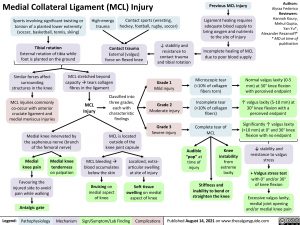Medial Collateral Ligament (MCL) Injury
Previous MCL injury
Ligament healing requires
adequate blood supply to bring oxygen and nutrients to the site of injury
Incomplete healing of MCL due to poor blood supply
Authors: Alyssa Federico Reviewers: Hannah Koury, Mehul Gupta, Yan Yu*, Alexander Rezansoff* * MD at time of publication
Sports involving significant twisting or torsion of a planted lower extremity (soccer, basketball, tennis, skiing)
Tibial rotation
External rotation of tibia while foot is planted on the ground
High-energy trauma
Contact sports (wresting, hockey, football, rugby, soccer)
Contact trauma
External (valgus) force on flexed knee
↓ stability and resistance to contact trauma and tibial rotation
Grade 1
Mild injury
Grade 2
Moderate injury
Grade 3
Severe injury
Similar forces affect surrounding structures in the knee
MCL injuries commonly co-occur with anterior cruciate ligament and medial meniscus injuries
Medial knee innervated by the saphenous nerve (branch of the femoral nerve)
MCL Injury
Classified into three grades, each with characteristic findings
MCL is located outside of the knee joint capsule
Microscopic tear (<10% of collagen fibers torn)
Incomplete tear (>10% of collagen fibers)
Complete tear of MCL
Normal valgus laxity (0-5 mm) at 30° knee flexion with perceived endpoint
↑ valgus laxity (5-10 mm) at 30° knee flexion with a perceived endpoint
Significantly ↑ valgus laxity (>10 mm) at 0° and 30° knee flexion with no endpoint
↓ stability and resistance to valgus stress
+ Valgus stress test
with 0° and/or 30° of knee flexion
Excessive valgus laxity, medial joint opening and/or medial knee pain
MCL stretched beyond capacityàtears collagen fibres in the ligament
Medial knee pain
Medial knee tenderness on palpation
MCL bleedingà blood accumulates below the skin
Bruising on medial aspect of knee
Localized, extra- articular swelling at site of injury
Soft tissue swelling on medial aspect of knee
Audible “pop” at
time of injury
Knee instability from extreme laxity
Favouring the injured side to avoid pain while walking
Antalgic gate
Stiffness and inability to bend or straighten the knee
Legend:
Pathophysiology
Mechanism
Sign/Symptom/Lab Finding
Complications
Published August 14, 2021 on www.thecalgaryguide.com

